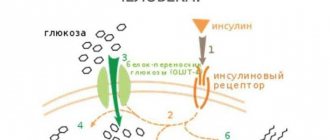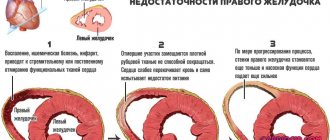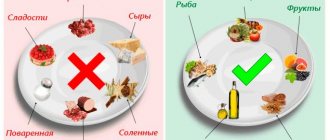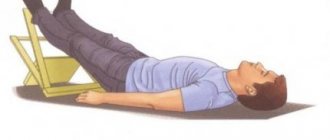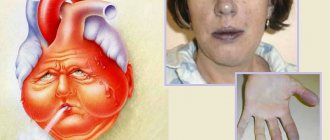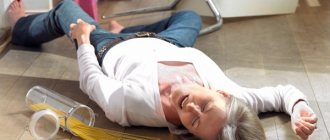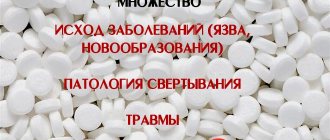Can there be cramps with hypertension or low blood pressure? The manifestation of a sharp convulsive syndrome is one of the signs warning of an impending disease crisis. When a muscle spasm occurs, a person not only loses control of the upper and lower limbs, but may even fall into unconsciousness. In most episodes, convulsions with problematic blood pressure are observed at night and appear unexpectedly.
Is there a relationship between seizures and blood levels, what to do in this situation, and what treatment is prescribed? These and other questions regarding muscle spasms are of interest to patients with cardiovascular diseases.
How are seizures and blood pressure related?
A cramp is an unintentional spasm (contraction) of a muscle that occurs in many diseases, including hypertension and ICP.
At the moment of convulsive manifestation, soft muscle tissue instantly acquires hardness, density and begins to twitch. This happens due to the fact that the nerve cells of the brain experience strong tension, which they signal to the muscles located in different parts of the body. All this provokes their involuntary compression. Seizures are most often observed in the following categories of people:
- Patients over 60 years of age (40% of them experience muscle spasms 3 times a week), especially with cardiovascular diseases.
- Pregnant women (every third of women experience leg convulsions during pregnancy).
Depending on the number of muscles affected by the cramp, it can be of the following type:
- Localized.
- Generalized.
They cause excessive excitability of neurons in the cortex or subcortical systems of the brain, which is already a pathology.
Convulsions with hypertension
Hypertensive patients often ask whether seizures occur with high blood pressure, and is there a connection between them? With high blood pressure, even a sharp jump in blood pressure can lead to a spasm. This muscle reaction occurs suddenly and is uncontrollable, but passes quickly (from 10 seconds to several minutes), but after some time it may recur. The painful sensation as a consequence of convulsions persists for several days.
Cramps occur in the following parts of the body:
- Hands.
- Legs.
- Neck.
- Stomach.
- Feet.
- Back.
- Hips.
Most often, spasm manifests itself in the calf muscles. In some cases, it can also manifest itself in internal organs, although this phenomenon is rarely observed.
Convulsive crisis
Can high blood pressure cause seizures during a hypertensive exacerbation? The development of a convulsive form of hypertensive crisis is considered one of the most dangerous complications for the life of a hypertensive patient, which can cause rapid death.
True, such a clinical condition is a rare phenomenon, and manifests itself only with the development of encephalopathy, which is accompanied by cerebral edema or as aggravation of hemorrhage into it. The reason for this clinic is explained by the rapid increase in blood pressure and the inability of cerebral arterioles to respond normally to a blood surge. Swelling of the brain tissue often lasts for several days.
In cases where convulsions due to hypertensive pressure are repeated with periodic frequency and are accompanied by severe pain, it is necessary to call a medical team.
After a hypertensive attack, the patient:
- He remains unconscious for a long time.
- Partial loss of memory (amnesia).
- Temporarily loses vision.
- Cannot navigate in space.
At worst:
- Falls into a comatose state.
- Paresis develops.
- Death occurs due to the inability of the heart to overcome the stress that has arisen.
This form of hypertensive attack is considered the most complex and difficult to treat. Therefore, you should try not to bring a patient with hypertension to a similar state.
Convulsions due to hypotension
Why does convulsive muscle contraction occur during hypotension? Cramps with low blood pressure are a characteristic symptom indicating the severity of fainting. In medicine, it is called “convulsive fainting,” when a person is completely unconscious, while the muscles of the limbs involuntarily shake. The manifestation of this form of loss of consciousness is accompanied by a partial tonic or generalized convulsion. Tonic convulsions often manifest as single clonic jerks.
After severe fainting, a hypotensive patient remains for a long time:
- Nausea.
- Prostration.
- Abdominal pain.
Convulsions with hypotonic blood pressure can also occur with cardiac (vagal) syncope:
| Duration of the condition | Symptoms |
| With asystole up to 10 seconds. | There is a loss of consciousness of 1-2 degrees, in which consciousness is restored immediately. |
| If you faint for more than 15 seconds. | Convulsions, involuntary urination and cyanosis are noted. After hypotension, bradycardia and poor health are diagnosed, and the pressure begins to drop sharply. |
The cause of convulsive spasms can also be the uncontrolled use of medications that normalize low blood pressure.
Convulsive hypertensive crisis
The convulsive form of hypertensive crisis is one of the most serious complications that can lead to death. It occurs very rarely - in the case of acute encephalopathy with cerebral edema or preliminary hemorrhage into it. As a rule, it occurs due to the same sudden surges in pressure and the inability of the cerebral arterioles to adequately respond to them. In this case, cerebral edema can persist for several days. After the attack, the patient may:
- be unconscious for a long time;
- lose orientation in space;
- partially lose memory in the form of amnesia;
- have transient amaurosis.
The worst outcome of a convulsive crisis is either death caused by the inability of the heart to cope with the stress, or coma, or the occurrence of paresis. One way or another, it is not recommended to bring the patient to such a state, because this is fraught with great dangers.
Other triggers for muscle spasms
The risk of muscle contractions does not depend on the specific tonic state of the muscle (stressed or weakened). Often, a spasm can occur during excessive physical effort or during sleep, as well as at high body temperature.
Among other reasons leading to the manifestation of muscle convulsions, medicine names:
- Lack of vitamins.
- Prolonged uncomfortable position.
- Intense physical stress.
- Unhealthy habits.
- Lack of fluid in the body.
- Diabetes.
- Overheating or hypothermia of the body.
- Rapid rise in temperature.
- Acute psychosis.
- Epilepsy.
- Tetanus.
- Traumatic brain injury.
- Severe poisoning.
- Intracranial hemorrhage.
- Diseases of the endocrine system.
- Postoperative rehabilitation period.
If seizures occur with frequency, medical consultation is necessary to determine the root cause and eliminate it.
Cardiac ischemia
One of the most serious consequences of hypertension is cardiac ischemia. With hypertension, when physical or psychological stress increases, the heart needs more oxygen. Its supply is disrupted due to partial blockage of the coronary artery. As a result of physical activity, substernal compressive pain occurs, which can last from a few seconds to half an hour. This is the first sign of angina. The condition can be alleviated with nitroglycerin.
- ECG;
- ECHO CG;
- stress tests;
- ECG monitoring throughout the day;
- coronary ventriculography (study of the functions of the left ventricle of the heart and coronary arteries);
- myocardial perfusion scintigraphy (study of blood supply to the myocardium of the left ventricle of the heart).
Hypertension pain may have a short-term effect. This does not mean that the disease has gone away completely. An insidious illness will make itself felt at the most inopportune moment.
Remember: the most common symptoms of high blood pressure are headaches, poor sleep, nervousness and fatigue. If hypertension is left untreated, problems with the cardiovascular system may occur. They manifest themselves in the form of rapid heartbeat, cardiac colic, and shortness of breath. Any of these symptoms should be a reason to see a doctor.
THERE ARE CONTRAINDICATIONS CONSULTATION WITH YOUR DOCTOR IS REQUIRED
Author of the article Svetlana Anatolyevna Ivanova, general practitioner
Higher education:
Saratov State Medical University named after. IN AND. Razumovsky (SSMU, media)
Level of education - Specialist
Additional education:
1990 - Ryazan Medical Institute named after Academician I.P. Pavlova
Muscle tension means a condition in which the muscles of the body remain toned for a long period. Muscular hypertension is usually caused by the physiological effects of stress and can lead to attacks of back pain.
Symptoms of seizures
Muscle spasm is not the only symptom that warns of the onset of convulsions. Despite their unexpected occurrence, their approach is indicated by characteristic signs depending on the severity of the seizures and their type.
The most dangerous form of seizures is an epileptic attack, in which the health of the sick person is extremely poor.
| Signs of an upcoming seizure | Signs of seizures during an epileptic attack |
| Slight darkening of the pupils. Snort. Slight tingling in the muscles. Confusion in consciousness. Changes in the perception of tastes and smells. Unintelligible speech pronunciation. Involuntary twitching of some part of the body. | Complete inability to pronounce a word. Manifestation of extreme fear. Severe dizziness. Excessive salivation. Foaming from the mouth. Increased nausea. The head and eyes are directed in opposite directions. |
If the progression of the disease has gone far enough and there is no proper therapy, then urinary and fecal incontinence is added to the above-described clinical picture, and the likelihood of fainting increases.
The duration of an epileptic seizure is about 2 minutes, then the person loses consciousness, and when clarity returns to him, he remembers absolutely nothing. The more symptoms appear, the higher the risk of disease progression and the likelihood of severe complications.
Vascular spasms with high blood pressure
Can there be cramps with hypertension or low blood pressure? The manifestation of a sharp convulsive syndrome is one of the signs warning of an impending disease crisis.
When a muscle spasm occurs, a person not only loses control of the upper and lower limbs, but may even fall into unconsciousness.
In most episodes, convulsions with problematic blood pressure are observed at night and appear unexpectedly.
Is there a relationship between seizures and blood levels, what to do in this situation, and what treatment is prescribed? These and other questions regarding muscle spasms are of interest to patients with cardiovascular diseases.
Which doctor should you contact for seizures?
If independent treatment measures do not help get rid of the symptoms of seizures and the condition worsens, you need to call emergency help. In this case, the ambulance doctor:
- Initially relieves convulsive syndrome.
- Then he prescribes full-fledged therapy.
It is necessary to seek advice not only from a therapist, but also from specialized specialists:
- Neurologist.
- Surgeon.
- Psychologist.
- Neuropathologist.
Such a thorough examination of the body will not be superfluous, since the true cause of convulsions may be related to the broad field of medicine.
What to do before the doctor arrives
First aid for hypertension is a gradual decrease in blood pressure. Antihypertensive drugs are more effective in this regard. Lowering blood pressure too quickly is very dangerous. The patient may faint or have a stroke. The pressure must be reduced by only 20% during the first two hours. Normalize completely - no earlier than six hours. That is why it is important to know what can be done during a hypertensive crisis and what cannot be done. Emergency care at home is taking medications. It is better not to use drugs of the antagonist group or sartans to quickly lower blood pressure. They are slowly absorbed into the blood and may not be effective in combating high blood pressure in emergency situations. What else you shouldn’t do is get to the hospital on your own, move around the house. Any movement will only worsen the condition, as it leads to an even greater increase in pressure.
Why is this condition dangerous?
Leg cramps with high blood pressure indicate an advanced stage of hypertension, which means that the patient’s life is in danger. Cardiologists emphasize that if spasms begin and a hypertensive patient loses consciousness, it means that the course of the disease has become very complicated.
In this situation, prompt qualified medical care is needed, which will help prevent death.
- If convulsive seizures follow a series (one after another), and consciousness does not return to the person between them, this condition is an extremely serious clinical picture.
- The danger of involuntary contractions of muscle tissue is also that at the moment of their spasm, vital muscles of the body, for example, respiratory muscles, can be affected. Breathing stops, oxygen supply to the brain stops, which leads to irreversible consequences.
- If muscle tone is impaired, the tongue may sink, which will lead to blockage of the airways.
- At the time of spasm, a significant amount of various substances, including potassium, are released into the blood, especially with a generalized type of spasms. The increased presence of this trace element is dangerous for cardiac arrest.
Pressure during vasospasm
When the lumen between the walls of arteries, capillaries, and arterioles decreases, a prolonged contraction of brain tissue occurs—a spasm, which increases the pressure inside the skull.
There is a restriction of blood circulation in the brain, and, as a result, a lack of nutrients. Brain spasms cause serious illness and death.
It affects men several times more often than women.
Cerebral vasospasm (spasm of cerebral vessels) often occurs in young people, although it used to predominate in older people.
Pressure as one of the causes of vasospasm
Etiology of occurrence:
- atherosclerosis;
- a sharp drop in pressure;
- head injuries;
- cervical osteochondrosis;
- hypertension;
- hypothalamic syndrome;
- decreased elasticity of blood vessels;
- hydrocephalus;
- inflammation of the lining of the brain;
- thromboembolism;
- hemorrhage;
- neurogenic pathologies;
- vasculitis;
- spine pathologies;
- aneurysm;
- connective tissue diseases;
- kidney pathologies;
- angina pectoris;
- endocrine diseases;
- brain tumors;
- vegetative-vascular dystonia.
A head injury can lead to complications such as cerebral vasospasm.
Risk factors:
- heredity;
- weather dependence;
- congenital vascular anomalies;
- dehydration;
- lack of sleep;
- changes in atmospheric pressure;
- alcohol;
- stress;
- strong tea and coffee;
- lack of fresh air;
- chronic fatigue;
- smoking;
- emotional shock;
- drugs;
- pregnancy;
- magnetic storms;
- 35–45 years of age;
- intoxication;
- birth injuries.
The effects of high blood pressure on blood vessels:
- disruption of the muscle layer;
- more intense or intermittent contraction of the vascular walls;
- blockage of blood flow;
- heart rhythm disturbance.
Symptoms of pathology
At the first symptoms, you need to consult a doctor to establish the correct diagnosis.
Symptoms vary based on factors:
- vessel size;
- duration of spasm;
- localization of pathological spasms.
Symptoms:
- headache;
- neuralgia;
- compression of the head;
- dizziness;
- numbness of lips;
- low pressure;
- destruction of the vitreous body;
- pallor;
- severe fatigue;
- fainting state;
- memory impairment;
- nausea;
- change in heart rate;
- neck or eye pain;
- high pressure;
- sweating;
- lack of coordination;
- pulsation in temples.
With vasospasm, which is preceded by a stroke or rupture of an aneurysm, severe symptoms occur:
- vomit;
- speech disorder;
- paralysis of part of the face;
- hearing problems;
- fainting;
- partial dysfunction of the limbs.
How to treat pathology?
Spasms of cerebral vessels need to be treated urgently, since this pathology sometimes causes irreversible consequences. Such as:
- visual impairment;
- ischemic disease;
- cerebral hemorrhage;
- myocardial infarction;
- stroke;
- death.
The following will help you independently relieve spasm of the blood vessels in the head and neck:
- cold foot baths;
- lying position;
- ice compress made from herbal infusion;
- self-massage of the back of the head and temples;
- aromatherapy based on lavender and jasmine;
- washing with ice water.
Herbal decoctions can bring temporary relief.
To relieve symptoms, take orally:
- decoction of garlic and thyme;
- warm water with honey;
- a decoction based on yarrow, valerian, motherwort, anise.
Medicines that help relieve symptoms:
- "Ibuprofen";
- "Aspirin";
- "Nurofen";
- "Spazgan".
Doctors prescribe medications as shown in the table:
| Type | Name |
| Calcium antagonists | "Adalat", "Corinfar" |
| Tranquilizers | "Relanium", "Seduxen" |
| Painkillers | "Papazol", "Eufillin", "No-shpa" |
| Nootropics | "Piracetam", "Nootropil" |
| Antidepressants | "Amitriptyline", "Azafen" |
| Adaptogens based on lemongrass, ginseng, aralia, eleutherococcus, pantocrine | |
| Sedatives based on valerian, corvalol, motherwort |
Spasm of blood vessels in the head cannot be ignored. When the first signs of the disease appear, you need to seek medical help.
Only an experienced doctor will be able to establish the correct diagnosis and prescribe adequate treatment.
Because with VSD, high blood pressure (hypertension), atherosclerosis and a number of other diseases, a similar clinical picture is sometimes visible. With timely treatment, the disease has a favorable prognosis.
Source: https://EtoDavlenie.ru/dav/bolezni/spazmy-pri-davlenii.html
First aid for seizures
At the time of a convulsive spasm, the provision of competent emergency care plays an important role. The patient’s further condition depends on how correctly it is provided, especially with severely manifested convulsions.
Before the ambulance arrives, you should not give any medications. In this situation you should:
- Place the patient in an upright position on a soft surface, as he may fall. You should turn your head to the side and try to relax the cramped muscles as much as possible.
- Remove clothes that restrict your body.
- Open the window to allow fresh air to flow in, which will provide additional oxygen.
- If you have difficulty breathing, use an oxygen bag or perform artificial respiration. This procedure is performed only after the convulsions are completed.
- Turn off the lights, eliminate loud noise and all irritants that worsen the patient’s well-being.
- If your body temperature has increased, try to normalize it with massage rubbing.
- If a partial spasm occurs, try to prevent the patient from clenching the teeth too hard.
At the moment of a cramp, a person can help himself - try to stretch the compressed muscle, lengthening it, or vigorously knead it. However, this method only works for mild spasmodic syndrome, and for more severe forms it is ineffective.
Features of muscle cramp therapy
In most cases, when convulsions occur frequently, the following medications are recommended:
- Difenin.
- Baclofen.
- Hexamidine.
- Benzonal.
- Phenobarbital.
- Carbamazepine.
These medications should be taken in a course. However, after its completion, you cannot abruptly stop taking them, otherwise an attack of epilepsy may occur. Medicines are taken for several years, which allows for a full recovery.
In addition to drug intervention, experts advise adhering to certain recommendations and performing medical procedures that also help normalize the patient’s well-being:
- Acupuncture.
- Physiotherapy.
- Drink enough fluid.
- In hot weather, drink at least 1 liter of salted chilled water (1 teaspoon of salt per 1 liter of water).
- Clearly define your daytime wakefulness and nighttime sleep patterns.
- Massage areas of the body where spasms most often occur.
Massage manipulations can increase blood circulation and improve oxygen delivery to problematic muscle tissues. In this case, strong stroking of the skin, the movements of which are directed towards the heart, has worked well. To obtain a more effective result, it is recommended to use essential oils:
- Lavender.
- Marjoram.
- Rosemary.
- Juniper.
They have a beneficial effect on blood circulation, return the skin to its normal color, and accelerate the flow of blood fluid. After such a massage, muscle relaxation is observed, and cramps disappear.
In cases where drug treatment and accompanying procedures are ineffective, the patient is prescribed additional examination, including hardware:
- Brain MRI.
- Electroencephalography.
Based on the examination results, the doctor determines what exactly led to the complications and selects more intensive therapy.
Preventing muscle spasms
To prevent pressure surges and seizures, you must follow simple recommendations:
- Adjust your daily routine.
- Night sleep should not be less than 8 hours.
- You should sleep in comfort and the most comfortable position.
- Drink enough fluids to avoid dehydration.
- Be sure to strengthen your immune system.
- Adhere to proper nutrition (eat foods rich in magnesium, potassium and calcium).
- Engage in feasible physical activities, avoiding the manifestation of convulsive contractions.
- Treat infectious and inflammatory diseases in a timely manner.
- Take good care of your health.
Vascular spasms and pressure
Blood pressure during vascular spasm, which is widespread, increases greatly.
If the pathology is local in nature and is located in the neck, which often happens with VSD or osteochondrosis, then the patient experiences a weakening of cerebral blood flow and the development of severe neurological symptoms associated with ischemia of nerve tissue. Treatment of the disease consists of eliminating the main causes of spasm and symptomatic treatment of neurological disorders.
Constriction of the blood vessels in the head is very dangerous and can lead to a stroke.
Causes and pathogenesis
An increase in blood pressure, which occurs when blood vessels spasm, can be provoked by the following factors on the human body:
- brain damage;
- tumor process;
- preliminary sharp drop in blood pressure;
- osteochondrosis of the cervical spine;
- atherosclerosis;
- hypothalamic-pituitary syndrome;
- vegetative-vascular dystonia;
- hormonal imbalance;
- decreased elasticity of blood vessels;
- hydrocephalus;
- aortic aneurysm;
- connective tissue pathologies;
- meningitis;
- hemorrhage into nerve tissue;
- kidney disease;
- alcohol consumption;
- frequent stress;
- smoking;
- lack of sleep;
- weather dependence;
- hereditary predisposition;
- vascular abnormalities;
- overwork;
- intoxication;
- obesity;
- inactive lifestyle;
- pregnancy.
This disease disrupts the functioning of the brain.
Spasm of cerebral vessels leads to disruption of the functional activity of the muscle layer, which causes blood flow to stop or slow down due to the small diameter of the lumen of the vascular bed. As a result, the normal volume of blood is compressed, which causes high blood pressure.
This phenomenon provokes disruption of the heart, so it is no longer able to effectively pump blood throughout the body. In this case, ischemia of various organs and tissues is observed, as a result of which the nervous tissues suffer the most, which provokes their death and disruption of the functional activity of the brain.
What happens to the pressure?
When vasospasm occurs, blood pressure increases and the patient develops characteristic symptoms, such as:
- headache;
- dizziness;
- loss of consciousness;
- increased heart rate;
- dyspnea;
- nausea followed by vomiting;
- Pain in the eyes;
- increased sweating;
- visual impairment, hearing impairment;
- stroke;
- neurological disorders;
- pale skin;
- paralysis and paresis.
Narrowing of the lumen of the coronary arteries of the heart is very dangerous for human life and health.
With uniform spasm of blood vessels throughout the body, a person experiences high blood pressure. If the decrease in lumen diameter is local in nature, then the symptoms depend on the location, severity and duration.
This condition is especially dangerous for the vessels of the brain and heart, as it can provoke tissue ischemia with subsequent necrosis and disruption of functional activity, which leads to severe neurological disorders and death.
How to treat?
The use of various medications will help relieve spasms. The most effective among them are peripheral vasodilators, antispasmodics and serotonin and calcium channel blockers.
They cause vasodilation by relaxing smooth muscles and blocking the nerve endings that are responsible for their narrowing. In addition, physiotherapeutic methods of influence are used.
For high blood pressure, acupuncture, magnetic therapy, electrophoresis, therapeutic massage and other useful procedures will help. In combination with the main therapy, it is possible to use non-traditional methods of influence.
Drugs
Drug treatment includes the use of peripheral vasodilators, which expand the lumen of small vessels and improve blood supply to tissues. For this purpose, “Nitroglycerin” or “Sodium Nitroprusside” is used.
Antispasmodics such as Drotaverine, Platifillin and Eufillin help relax the smooth muscles of blood vessels of all sizes. Also used are serotonin receptor blockers "Ketanserin" and substances that block slow calcium channels "Nifedipine", "Alprostadil", "Verapamil" and others.
Antiplatelet agents and thrombolytics will help prevent blockage of blood vessels. The use of vitamin-mineral complexes is also indicated.
Traditional treatment
In alternative medicine, the following recipes are used to treat vasospasm:
An infusion of valerian root is widely used in treatment.
- infusion of valerian root;
- periwinkle decoction;
- motherwort tincture;
- rowan, boiled in a water bath;
- water infusion of viburnum flowers;
- eating carrot seeds.
other methods
If conservative treatment methods are ineffective, it is recommended to treat vascular spasm surgically. The essence of the intervention is the intersection of nerve fibers and nodes that innervate the vessels and lead to their narrowing. When the lumen of vital arteries in the brain or heart decreases, vascular stents are installed, which mechanically expand the narrowing area.
The use of physiotherapeutic methods will help improve the patient's condition.
How to warn?
Prevention of vascular spasm consists of a correct lifestyle, adherence to a daily routine with a sufficient period of rest and dosed physical activity.
It is important to get enough sleep and watch your diet. You need to get rid of bad habits and eliminate fatty, fried and spicy foods from your diet.
It is necessary to give preference to vegetables and fruits containing large amounts of healthy vitamins.
Source: https://VseDavlenie.ru/problemy/bolezni/davlenie-pri-spazme-sosudov.html
